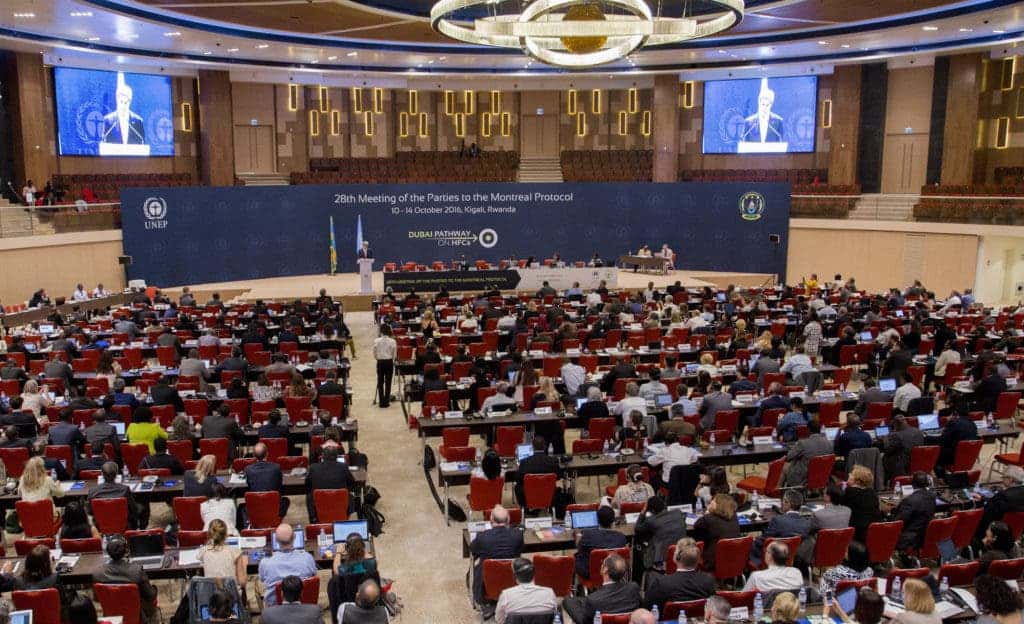
At Kigali, the capital of Rwanda, 170 nations signed a landmark climate deal that will impose a worldwide ban on chemical coolants called hydrofluorocarbons, or HFCs. These are used in refrigerators and air conditioning systems but also act as a potent greenhouse gas trapping 1,000 times more heat than carbon dioxide. Though the announcement was met with far less fanfare than the Paris Agreement signed last December, the Kigali pact is one of the most important climate accords of the century.
Refrigerators that warm the planet
In the 1980s, scientists made a discovery that made everyone tremble with unease. They had found a huge hole in the ozone layer above Antarctica that threatened life there, but also the ice sheets. Investigations revealed that the hole was made by refrigerating chemicals known as chlorofluorocarbons (CFCs). There aren’t that many instances we can remember when the world banded together under the common good but it happened in this case. In 1987 an emergency UN panel banned CFCs and though it took a couple of decades, the ozone has replenished back to pre-1980s levels.
However, CFCs were replaced by a lesser evil — the HFCs. While HFCs don’t drill holes in the ozone, they trap a lot of heat making them one of the most potent greenhouse gasses.
UPDATED – Explainer: Why a UN climate deal on HFCs matters | @some_yeo #MontrealProtocol #hfc #kigali https://t.co/diJfms6KQV pic.twitter.com/sdvkgPOd5i
— Carbon Brief (@CarbonBrief) October 15, 2016
Seven years in the making, the deal hammered out at Kigali on Oct. 15 will see HFCs finally banned and replaced with climate-friendly alternatives.
“In addition to today’s amendment, countries last week crossed the threshold for the Paris Agreement to enter into force and reached a deal to constrain international aviation emissions,” President Obama said Saturday. “Together, these steps show that, while diplomacy is never easy, we can work together to leave our children a planet that is safer, more prosperous, more secure and more free than the one that was left for us.”
The Paris Agreement was far more grandiose both in statement and in purpose — the pact aims to limit global warming to no more than two degrees Celsius past Industrial Age levels, and will see drastic reductions in greenhouse gas emissions — but compared to Kigali, it is very broad.
Following the #ParisAgreement, world leaders committing to phase down #HFCs in #Kigali for the #MOP28 is an encouraging step forward
— Al Gore (@algore) October 15, 2016
The Kigali accord defines clear timelines of HFC phase out, penalties for those who break the deal, and procedures for rich countries to finance developing countries in their quest to transition to an HFC alternative. Additionally, Kigali is also legally binding.
Like any major international accord, Kigali was no easy negotiation. Some rich countries, like the United States, asked for stricter conditions, wanting the withdrawal of HFCs much quicker. Other countries, like India where millions are on the brink of affording air conditioning (and they desperately need it), asked for more understanding.
The final deal will see rich countries, like the United States or those in the European Union, freeze production and consumption of HFCs by 2018. The rest of the world, which includes China, Brazil and all of Africa, will use HFCs until 2024. India, Pakistan, Iran, Saudi Arabia and Kuwait were given a break — they have to freeze production by 2028 or later than anyone else.
“The amendment means a lot to us,” said Rwandan negotiator Juliet Kabera. “It fosters commitment towards climate change mitigation globally, even if Rwanda is not a big consumer of HFCs. Championing this cause puts us in a leadership position which makes us very proud”.
Overall, it’s thought the HFC ban will see the equivalent of 70 billion tons of carbon dioxide being kept away from the atmosphere. That’s two years worth of man-made carbon spewed into the atmosphere on a planetary scale.
The Kigali Agreement to the Montreal Protocol reached this morning is a historic occasion, which will have a lasting impact on our planet.
— Narendra Modi (@narendramodi) October 15, 2016
In the U.S. at least, companies have already adapted. The Wall Street Journal reports Chemours Co., a DuPont spin-off, introduced a new line of gasses to help replace HFCs for certain industrial-scale refrigeration and air-cooling systems. Johnson Controls Inc. also announced two new building-cooling systems that use an alternative to HFCs.
All in all, though HFCs account for only 1% of global greenhouse-gas emissions and 1.5% of all U.S. greenhouse-gas emissions, the Kigali deal is a landmark achievement. Coupled with the announcement that the Paris Agreement came into force after the ’55 countries totaling 55% of global emissions threshold’ was met, we can only rejoice.
At the same time, we must realize it will only get tougher. Not one single cent of the $100 billion promised in Paris by rich countries to help developing nations build their renewable energy infrastructure has been seen. Greenhouse gasses are still following a yearly rise trend. The oceans are getting more acidic and the atmosphere more clogged with heat-trapping gasses.
I’ll open that champagne when we see less, not more carbon in the atmosphere.


